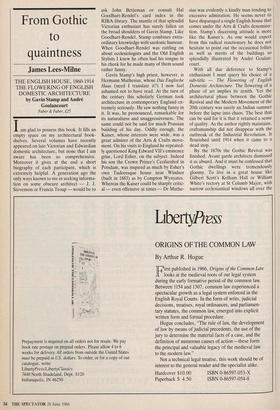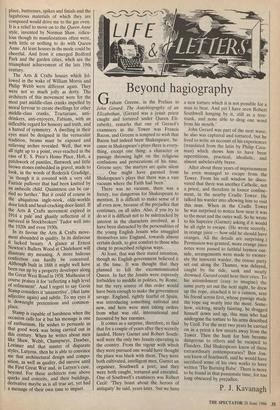From Gothic to quaintness
James Lees-Milne
THE ENGLISH HOUSE, 1860-1914 THE FLOWERING OF ENGLISH DOMESTIC ARCHITECTURE by Gavin Stamp and Andre Goulancourt
Faber & Faber, f25
Iam glad to possess this book. It fills an. empty space on my architectural book- shelves. Several volumes have recently appeared on late Victorian and Edwardian domestic architecture, but none that I am aware has been so comprehensive. Moreover it gives at the end a short biography of each participant, which is extremely helpful. A generation ago the only ways known to me in seeking informa- tion on some obscure architect — J. J. Stevenson or Francis Troup — would be to ask John Betjeman or consult Hal Goodhart-Rendel's card index in the RIBA library. The mantle of that splendid Victorian enthusiast has surely fallen on the broad shoulders of Gavin Stamp. Like Goodhart-Rendel, Stamp combines extra- ordinary knowledge with sardonic humour. When Goodhart-Rendel was rattling on about ecclesiologists and the Old English Stylists I knew he often had his tongue in his cheek for he made many of them sound rather funny.
Gavin Stamp's high priest, however, is Hermann Muthesius, whose Das Englische Haus (need I translate it?) I now feel ashamed not to have read. At the turn of the century this scholarly German took architecture in contemporary England ex- tremely seriously. He saw nothing funny in it. It was, he pronounced, remarkable for its naturalness and unaggressiveness. The same could not be said for much Prussian building of his day. Oddly enough, the Kaiser, whose interests were wide, was a great admirer of the Arts & Crafts move- ment. On his visits to England he repeated- ly questioned King Edward VII's eminence grise, Lord Esher, on the subject. Indeed his son the Crown Prince's Cecilienhof in Potsdam, was inspired as much by Esher's own Tudoresque house near Windsor (built in 1883) as by Compton Wynyates. Whereas the Kaiser could be sharply critic- al — even offensive at times — Dr Muthe- sius was evidently a kindly man tending to excessive admiration. He seems never to have disparaged a single English house that comes under the Arts & Crafts denomina- tion. Stamp's discerning attitude is more like the Kaiser's. As one would expect from this radical reactionary he does not hesitate to point out the occasional follies as well as merits of the buildings so splendidly illustrated by Andre Goulan- court.
With all due deference to Stamp's enthusiasm I must query his choice of a sub-title — The Flowering of English Domestic Architecture. The flowering of a phase of art implies its zenith. Yet the architectural phase between the Gothic Revival and the Modern Movement of the 20th century was surely an Indian summer before the lapse into chaos. The best that can be said for it is that it retained a sense of quality. As the author rightly maintains, craftsmanship did not disappear with the outbreak of the Industrial Revolution. It flourished until 1914 when it came to a dead stop.
By the 1870s the Gothic Revival was finished. Avant garde architects dismissed it as absurd. And it must be confessed that Gothic dwellings were tremendously gloomy. To live in a great house like Gilbert Scott's Kelham Hall or William White's rectory at St Columb Major, with narrow ecclesiastical windows all over the place, buttresses, spikes and finials and the lugubrious materials of which they are composed would drive me to the gas oven.
It is a relief to move on to the Queen Anne style, invented by Norman Shaw, ridicu- lous though its manifestations often were, with little or nothing to do with Queen Anne. At least houses in the mode could be cheerful. And from it emerged Bedford Park and the garden cities, whch are the triumphant achievement of the late 19th century.
The Arts & Crafts houses which fol- lowed in the wake of William Morris and Philip Webb were different again. They were not so much jolly as dotty. The architects of this movement were for the most part middle-class cranks impelled by moral fervour to create dwellings for other middle-class cranks, Tractarians, anti- drinkers, anti-enjoyers, Fabians, with an inflexible regard for honesty and truth, and a hatred of symmetry. A dwelling in their eyes must be designed in the vernacular tradition, beams must be exposed and relieving arches revealed. Well, that was all right up to a point, over-reached in the case of E. S. Prior's Home Place, Holt, a patchwork of pantiles, flintwork and little brown stones embedded in gravel, made to look, in the words of Roderick Gradidge, `as though it is covered with a very old Fairisle pullover that had been knitted by an imbecile child. Quaintness can be car- ried no further.' But it could of course in the ubiquitous ingle-nook, olde-worlde door latch and head-cracking door-lintel. If the Arts & Crafts movement expired in 1914 a pale' and ghastly reflection of it survived in Stockbrokers' Tudor well into the 1920s and even 1930s.
In its favour the Arts & Crafts move- ment abounded in quality. In its disfavour it lacked beauty. A glance at Ernest Newton's Butlers Wood at Chislehurst will illustrate my meaning. A more hideous confection can hardly be conceived. Although built in 1888 it might well have been run up by a property developer along the Great West Road in 1938. Muthesius of course praises it for 'reflecting a high level of refinement'. And I regret to say Gavin Stamp considers it 'unassertive', (that lame adjective again) and subtle. To my eyes it is downright pretentious and common- place.
Stamp is capable of harshness when the occasion calls for it but his message is one of enthusiasm. He wishes to persuade us that good work was being carried out in this century. When he writes about men like Shaw, Webb, Champneys, Dawber, Lorimer and that master of disparate styles, Lutyens, then he is able to convince me that architectural design and compo- sition, as well as quality, did survive until the First Great War and, in Lutyen's case, beyond. For these architects rose above quirks and conceits, and their buildings, derivative maybe as is all true art, yet had a message of their own time to impart.



















































 Previous page
Previous page